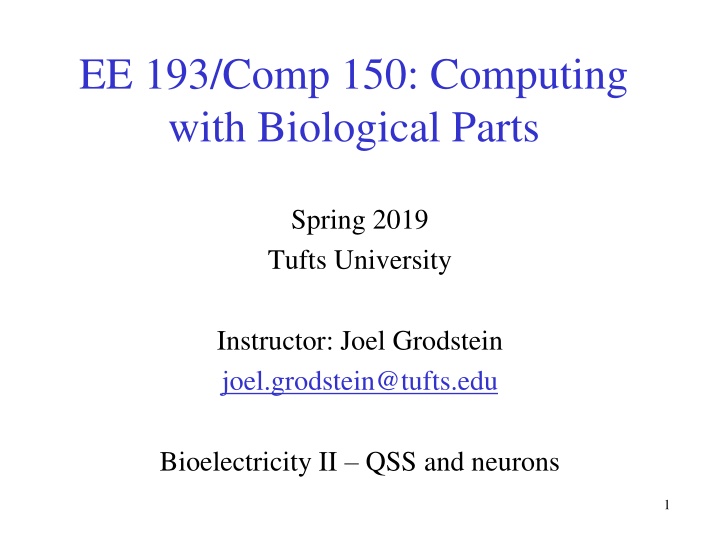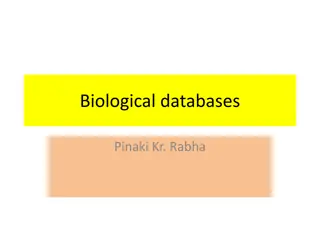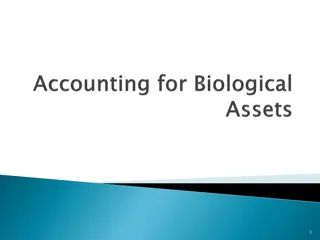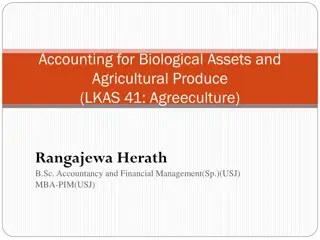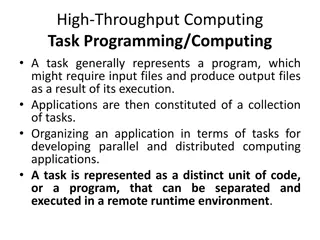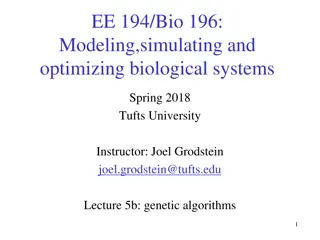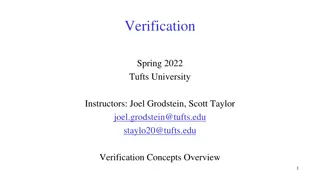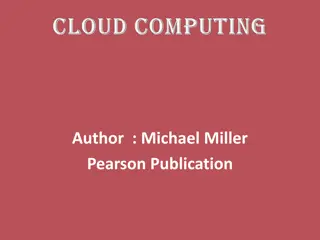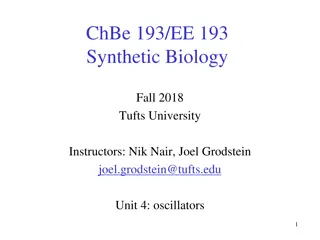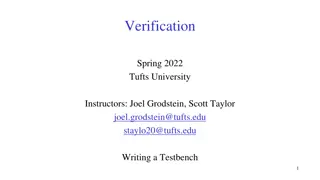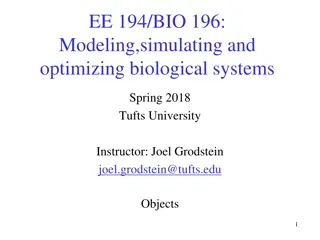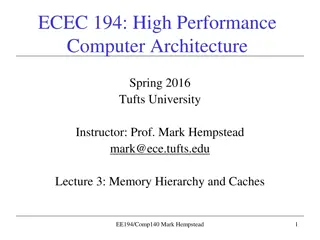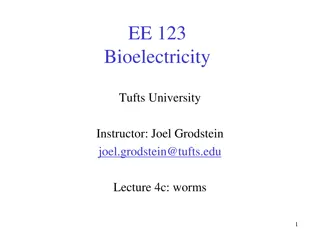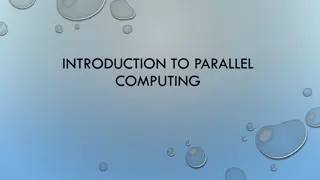Computing with Biological Parts at Tufts University
The fascinating world of bioelectricity and neurons in the context of computing at Tufts University. Delve into the intricate workings of cells and how they generate voltage, paving the way for understanding the lightning-fast processes of the human brain. Discover how bioelectricity enables swift computational abilities and learn about the operation of neurons at quasi-steady-state. Uncover the secrets of how our brains achieve remarkable speed in processing information, contrasting with the time scales of morphogenesis. Dive into the realm of bioelectricity and unlock the mysteries of neural computation.
Download Presentation

Please find below an Image/Link to download the presentation.
The content on the website is provided AS IS for your information and personal use only. It may not be sold, licensed, or shared on other websites without obtaining consent from the author.If you encounter any issues during the download, it is possible that the publisher has removed the file from their server.
You are allowed to download the files provided on this website for personal or commercial use, subject to the condition that they are used lawfully. All files are the property of their respective owners.
The content on the website is provided AS IS for your information and personal use only. It may not be sold, licensed, or shared on other websites without obtaining consent from the author.
E N D
Presentation Transcript
EE 193/Comp 150: Computing with Biological Parts Spring 2019 Tufts University Instructor: Joel Grodstein joel.grodstein@tufts.edu Bioelectricity II QSS and neurons 1
Lab #1, first plots EE 193/Comp 150 Joel Grodstein 2
Problem for the day We ran a bunch of simulations of cells They created voltage. Cool! Minor problem: Our sims took several hours of simulated time to reach steady state Our brains run on bioelectricity Any problem there? EE 193/Comp 150 Joel Grodstein 3
How can our brain be so fast? We humans can think pretty fast We can react pretty fast, too We cannot build a useful deep NN in our brain if each neuron takes hours to settle! Result: humans evolved a new way to use bioelectricity Operation at quasi-steady-state It s how neurons work. Computing on the time scale of hours is OK for morphogenesis We re in the womb for 9 months Our cuts & scapes heal over days/weeks But it s not OK for brains Or for animorphs https://www.youtube.com/watch?v=jEKPDgjERt0&list=PL9AC274019AC09106& index=3 4 EE 193/Comp 150 Joel Grodstein
What we will learn How to use bioelectricity to compute really fast How neurons work EE 193/Comp 150 Joel Grodstein 5
Back of the envelope speed Quick electricity problem: If the cell membrane is a capacitor C How much charge q must enter the cell to change the voltage by V? q=C V Typical planaria values: Radius of a cell = 5 Capacitance of the cell membrane = .05 F/m2 V = 50mV What is q? How long will it take to move Vmem by 50mV? Area of membr. = C = 4 * * (5 )2= 3x10-10 m2 (3x10-10 m2) * (.05 F/m2) =15x10-12 F (15x10-12 F)(.050V) = .75x10-12 C 2.5*10-12 C/s q = C V = Typical current = .75 10 12? 1 Time = ? 2.5 10 12?= .3? EE 193/Comp 150 Joel Grodstein 6
It only takes .3s to move Vmem around as much as needed! That s a planaria; humans are <1ms. Random factoids anybody know why human nerves are so much faster than worms? That s a lot faster than hours! Nice, but EE 193/Comp 150 Joel Grodstein 7
Why so fast And so C is small too. And q = CV, q = C V Why is this so fast? Four facts: Cells are very small Each has quite a lot of charge Inside and outside have very different concentrations from each other Biology has built sensitive sensors we need only move Vmem by 50mV Drift currents are quite high ???? ???? ??????= ???? ???? ??? diffusion currents are quite high ??????= ?? ?? Vmem can swing end to end very fast ?? EE 193/Comp 150 Joel Grodstein 8
But then why was Lab1 so slow? --- +++ 60mV 3Na+ [K+]=400mM [Na+]=50mM [Cl-]=52mM other-=408mM [K+]=20mM [Na+]=440mM [Cl-]=560mM other+=110mM 2K+ Blue arrows = diffusion Green arrows = electric current Red arrows = ion pump Bioelectricity has another trick up its sleeve. Consider increasing GNa Na+ is flowing inwards from both diffusion and drift, and then being pumped out Increasing GNa will increase the inwards flow; and not affect the outwards flow This all happens very fast concentrations barely change diffusion doesn t change (other than from GNa ). Higher Vmem will push Na+ out again We reach a Vmem higher enough to reduce drift enough to balance out the increased diffusion This is negative feedback EE 193/Comp 150 Joel Grodstein Vmem will get more positive (i.e., closer to 0) very quickly Are we done yet? At this new Vmem, is the flow of, say, Cl- balanced? 9
Were not at steady state --- +++ 60mV 3Na+ [K+]=400mM [Na+]=50mM [Cl-]=52mM other-=408mM [K+]=20mM [Na+]=440mM [Cl-]=560mM other+=110mM 2K+ Blue arrows = diffusion Green arrows = electric current Red arrows = ion pump Cl- is not balanced Cl-has no pump. It s only balanced when drift=diffusion. Are they balanced? Cl-diffusion is unchanged, but drift is changed Ditto for K+, in fact. What must change for Cl- to balance again (with this new drift)? ICF [Cl] must change enough to make a new diffusion. But that is what takes hours and not ms. Remember: unbalanced charge flow changes Vmem very fast, but [] changes slowly. So what s going on? Why do we think we can compute fast? so they cannot balance 10 EE 193/Comp 150 Joel Grodstein
Lab #1 picture again This time in more detail, from t=0 to t=30: really fast change really slow change EE 193/Comp 150 Joel Grodstein 11
--- +++ 50mV 3Na+ [K+]=400mM [Na+]=50mM [Cl-]=9mM other-=408mM [K+]=5mM [Na+]=145mM [Cl-]=140mM 2K+ Blue arrows = diffusion Green arrows = electric current Red arrows = ion pump Big picture: if you make Vmem more positive Diffusion and pump flows are unchanged Drift currents push positive ions out, negative ions in 12 EE 193/Comp 150 Joel Grodstein
flux (mM/m2s) -78 -60 0 +57 Vmem (mV) Consider the situation at SS before we changed GNa VN,Na=+57mV; VN,K=-78mV; VN,Cl=-60mV Can you draw the flux-vs-Vmem lines: the line for Cl? the line for K? the line for Na? EE 193/Comp 150 Joel Grodstein 13
--- +++ 60mV 3Na+ [K+]=400mM [Na+]=50mM [Cl-]=9mM other-=408mM [K+]=5mM [Na+]=145mM [Cl-]=140mM 2K+ Blue arrows = diffusion Green arrows = electric current Red arrows = ion pump Big picture: if you increase GNa Pump flows are unchanged Diffusion and drift both scale ??????= ?? ?? ?? ???? ???? ??????= ???? ???? ??? 14 EE 193/Comp 150 Joel Grodstein
flux (mM/m2s) -78 -60 0 +57 Vmem (mV) Vmem where Na flux=0 So let s increase GNa. How would that change the picture? Remember we re not at SS Total flux for Na need not be 0 at the SS Vmem There is a Vmem where Na flux = 0 But at that Vmem, clearly total flux for Cl and for K <0 >0 EE 193/Comp 150 Joel Grodstein 15
--- +++ 50mV 3Na+ [K+]=400mM [Na+]=50mM [Cl-]=9mM other-=408mM [K+]=5mM [Na+]=145mM [Cl-]=140mM 2K+ Blue arrows = diffusion Green arrows = electric current Red arrows = ion pump Big picture: if you make Vmem more positive Diffusion and pump flows are unchanged Drift currents push positive ions out, negative ions in Net result Cell trends more negative So it s a negative-feedback system again 16 EE 193/Comp 150 Joel Grodstein
flux (mM/m2s) Vmem where total flux of charge=0 -78 -60 0 +57 Vmem (mV) Vmem where Na flux=0 As Vmem gets larger, what happens to flux of Na? K? Cl? What happens to totalflux of charge? Is there some Vmem where total charge flux is zero? becomes more negative becomes more negative becomes more positive more negative EE 193/Comp 150 Joel Grodstein 17
flux (mM/m2s) We reach this Vmem quite quickly -78 -60 0 +57 Vmem (mV) What is the flux of individual ions at this Vmem? Na? K? Cl? At this Vmem, the charge in the cell stays constant so this Vmem is stable Individual ions typically have flux Ion concentrations change but very slowly EE 193/Comp 150 Joel Grodstein net flux into the cell ++ net flux out of the cell - net flux into the cell - 18
Lab #1 picture again Eventually we reach true SS Dynamic phase: Vmem swinging rapidly concentrations changing very slowly Thus so does Vmem EE 193/Comp 150 Joel Grodstein 19
ICF IK INa GK GNa GCl ? ? ? ?? ??? ??? 77mV -89mV -71mV ECF Our intuitive model tells us Vmem quite easily. KCL on the top node tells us when total charge flowing into the ICF is 0 This is exactly our condition for QSS! How accurate is this? We said that the G and Vnernst depend on [ions] In QSS [ions] has no time to change much, so our model is excellent Result: a simple model that accurately shows how changing G affects Vmem! EE 193/Comp 150 Joel Grodstein 20
Analysis intuition ICF IK INa GK GNa GCl Ashton s analysis ? ? ?? ??? ? ??? -89mV -71mV ECF 77mV ? ???????= 0 ? ???????+ ?? ? ??????+ ??? ?? ???+ ??? ???? ????+?? ???+??+??? ???+??? ?? ???+??? ????= What is the value of Vmem if, e.g., GNa gets very big? What if GNa and GK are both close to 0? Other conclusion: as (e.g.,) GNa rises, Vmem approaches ??? ? ???? ??? ? ???? ??? ? EE 193/Comp 150 Joel Grodstein 21
Vmem=-71mV ICF Na: (77+71)*.4 60 IK INa GK 2.2 GNa .4 GCl .4 No net Cl- flux 60 40 ? ? ?? ??? ? ??? K: (89-71)*2.2 40 77mV -89mV -71mV ECF Work an example with actual ion-channel conductance numbers Units? G is (nmoles/m2 s) per mVolt Ipump is nmoles/m2 s Values shown are steady-state: each individual ion is balanced Note the 3:2 ratio of pump currents Make sure that the direction of current flow makes sense for each ion! EE 193/Comp 150 Joel Grodstein 22
Vmem=-71mV Vmem=+19mV ICF Cl: (19+71)*.4 36 Na: (77-19)*5 292 IK INa 2.2 .4 5 .4 60 40 ? ? ?? ??? ? ??? K: (89+19)*2.2 236 -89mV 77mV ECF -71mV Now let s increase GNa We almost instantly get a new Vmem. Rough guess as to what it is? We ve tied Vmem more tightly to VNNa, and so Vmem moves closer to +77mV than -89mV Let s look at the new currents Which way does Na flow? K? Cl? Observation: each ion is individually unbalanced! In total: net flow entering the cell via ion channels = net flow exiting via pumps = EE 193/Comp 150 Joel Grodstein Into the cell, since Vmem=19mV and 19<77 Out of the cell, since 19 > -89 Into the cell, since 19 > -71 292 -236 - 36 = 20 60 - 40 = 20 23
QSS So we next start the hours-long march to change the concentrations enough to reach true SS again. The intermediate time frame: concentrations are slowly changing thus so does Vmem called quasi-steady-state EE 193/Comp 150 Joel Grodstein 24
Setup: GNa and GK originally set for -85mV At t=100s, they suddenly change Eventually we reach true SS Na+ K+ Cl- Thus so does Vmem Dynamic phase: Vmem swinging rapidly QSS: concentrations changing very slowly EE 193/Comp 150 Joel Grodstein 25
How neurons work Nature has built a pretty amazing system By altering GNa and GK, we can quickly swing between -89mV and +77mV We can build any waveshape by suitably altering GNa and GK ICF INa IK GK GNa GCl ? ? ?? ??? ? ??? -89mV 77mV -71mV ECF EE 193/Comp 150 Joel Grodstein 26
How neurons work If you were to guess, how do you think GNa and GK change over the course of a spike? Draw it. ICF IK INa GK GNa GCl ? ? ??? ? ?? ??? -89mV -71mV ECF 77mV EE 193/Comp 150 Joel Grodstein 27
How neurons work If you were to guess, how do you think GNa and GK change over the course of a spike? Draw it VN,Na=+54mV; VN,K=-90mV; VN,Cl=-70mV The Hodgkins-Huxley model: GNa and GK are given empirically by differential equations that match the behavior you predicted Na has high G Both return to baseline K has high G Na and K both have low G EE 193/Comp 150 Joel Grodstein 28
How neurons work If you were to guess, how do you think GNa and GK change over the course of a spike? Draw it VN,Na=+54mV; VN,K=-90mV; VN,Cl=- 70mV The Hodgkins-Huxley model: Differential equations for the blue and green curves Basic idea is voltage-sensitive ion- channel turnon GNa is an increasing function of Vmem; fast positive feedback generates the rising spike A slow negative-feedback mechanism shuts the spike off GK is the blue curve GNa is the green curve EE 193/Comp 150 Joel Grodstein 29
Traveling action potentials Start with an action potential at one end of a neuron it started when Vmem was pushed high enough Diffusion: it travels and damps but this pushes Vmem higher nearby Vmem nearby This is high enough to trigger an action potential over there! and over and over EE 193/Comp 150 Joel Grodstein 30
More facts about neurons synapse ANN nonlinear activation function sort of models this The brain has 100B neurons. Each dendrite takes inputs from 1000 other neurons and decides when to fire Most common model: Leaky Integrate and Fire. Each input pulse raises Vmem slightly; when we hit a threshold we fire An action potential then travels along the axon to the next downstream synapse(s) Electroceuticals: largely concerned with neurons Morphogenesis: non-neuronal cells computing and communicating bio- electrically EE 193/Comp 150 Joel Grodstein 31
Traveling action potentials Why don t they reverse direction? Why doesn t the green action potential at x=2 diffuse to x=1 as well as to x=3? It does diffuse. But x=1 is in refractory mode, and the diffusion can t bring it high enough to kick off an action potential x=2 x=1 +40 Vmem(mV) -55 -70 0 0 1 2 3 4 5 Time(ms) 32 EE 193/Comp 150 Joel Grodstein
A bit more Neurons are fast. Change GNa and/or GK near instant change in Vmem But the march to a new steady state starts instantly too if the changes in GNa and/or GK lasted long enough, the internal [Na], [K] and [Cl] would change Any consequences of that? the neuron would function differently at the next spike But it doesn t happen; we saw that neurons return to baseline quite quickly There s a good reason why action-potential spikes are short and sweet! EE 193/Comp 150 Joel Grodstein 33
Myelin Neurons are coated with myelin A fatty, non-conductive layer What good is myelin? Makes neurons propagate an action potential fast A big evolutionary step in our brains being useful But how does it work? Remember capacitance? Thick membrane low C Q=CV, so low C means faster or slower? Multiple sclerosis is an auto-immune disease where (among other issues) nerves get demyelinated faster. Takes less q to make enough V EE 193/Comp 150 Joel Grodstein 34
The problem with myelin ion channels Neuron without myelin Action potential travels slowly Gets regenerated frequently Neuron with myelin Ion channels cannot traverse the sheath Diffusion can make Vmem wave spread much faster. But Without ion channels, action potentials cannot regenerate! Die out before reaching the other end of the neuron Solution: Nodes of Ranvier Occasional gaps in the myelin sheath, big enough to allow AP regeneration EE 193/Comp 150 Joel Grodstein 35
Recap What can we compute in steady state over hours? A function Vmem = f (GNa, GK) Independent of initial concentrations [Na]int, [K]int, [Cl]int. Reasonably linear? I ve never seen a simplified description (but it would be a good final project) Morphogenesis is proposed to compute this way What can we compute in quasi steady state over milliseconds? A simple function Vmem = f (GNa, GK, GCl) It s reasonably linear In QSS, each ion individually has nonzero flux. So unless we quickly revert to default values, we get a long, slow march to SS This is how neurons work! EE 193/Comp 150 Joel Grodstein 36
Whats up next? Lab #2, cell voltages in QSS. Then the next unit: building non-neural neural networks EE 193/Comp 150 Joel Grodstein 37
analyze_equiv_network() tries to keep results pretty It sometimes only prints to one significant digit Here are some better numbers Na 3.19 71 810 K 38.4 -86 540 Cl 4.44 -25 G (mol/m2s per mV) Vnernst (mV) Ipump (mol/m2s) EE 193/Comp 150 Joel Grodstein 38
